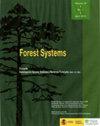Short communication: Variation of deadwood density by decay class in Douglas fir (Pseudotsuga menziesii (Mirbel) Franco) stands in Italy
IF 0.7
4区 农林科学
Q3 FORESTRY
引用次数: 1
Abstract
Aim of the study: To estimate fresh and basic density values of Douglas fir deadwood for the five decay classes used in the National Forest Inventories (NFIs). Area of study: Rincine forest in Tuscany region (Italy). Material and methods: 140 samples of Douglas fir deadwood (28 for each decay class; 14 of which were collected in summer and 14 in winter) were collected and analysed in the laboratory. The samples were weighed fresh, then placed in the oven for 3 days at 60°C. Afterwards the samples were weighed dried. The laboratory data were used to estimate moisture content (%), fresh and basic density by decay class. Main results: The results showed that the trend of basal density decreased from 1st to 5th decay class (0.43 g cm-3, 0.39 g cm-3, 0.37 g cm-3, 0.29 g cm-3 and 0.20 g cm-3). An average basic density of 0.34 g cm-3 could be used in future studies concerning the estimation of C-stock in Douglas fir deadwood. Research highlights: The moisture content of all decay classes of lying deadwood is influenced by the season (winter vs. summer) and consistent with the local climate regime.短通信:意大利花旗松(Pseudotsuga menziesii(Mirbel)Franco)林分枯木密度随腐朽等级的变化
研究的目的:估计国家森林调查(nfi)中使用的五种腐烂等级的花旗松枯木的新鲜密度和基本密度值。研究领域:意大利托斯卡纳地区的林辛森林。材料和方法:140个花旗松枯木样本(每个腐烂等级28个);其中夏季采集14份,冬季采集14份)在实验室采集分析。样品新鲜称重,然后在60°C的烤箱中放置3天。然后将样品称重,使其干燥。利用实验室数据,按衰变等级估算其含水率(%)、新鲜度和基本密度。主要结果:从第1级到第5级(0.43 g cm-3、0.39 g cm-3、0.37 g cm-3、0.29 g cm-3和0.20 g cm-3),基材密度呈递减趋势;平均基本密度为0.34 g cm-3,可用于估算花旗松枯木中碳储量的研究。研究重点:所有腐烂类型的躺着的枯木的水分含量受季节(冬季与夏季)的影响,并与当地的气候状况一致。
本文章由计算机程序翻译,如有差异,请以英文原文为准。
求助全文
约1分钟内获得全文
求助全文
来源期刊

Forest Systems
FORESTRY-
CiteScore
1.40
自引率
14.30%
发文量
30
审稿时长
6-12 weeks
期刊介绍:
Forest Systems is an international peer-reviewed journal. The main aim of Forest Systems is to integrate multidisciplinary research with forest management in complex systems with different social and ecological background
 求助内容:
求助内容: 应助结果提醒方式:
应助结果提醒方式:


